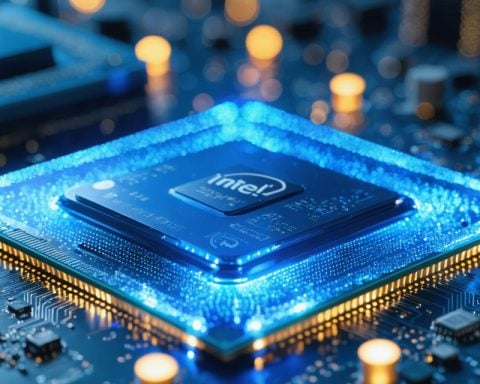- Intel is revolutionizing industries through its quantum computing and neuromorphic technology ventures.
- Quantum computing aims to surpass traditional systems and reshape industry norms with enhanced processing speeds and efficiencies.
- Neuromorphic chips emulate the human brain, promising to transform AI, robotics, and IoT with real-time processing capabilities.
- Quantum computing offers potential scientific breakthroughs but involves high costs and faces competitive challenges.
- Neuromorphic technology, still in its infancy, requires new programming techniques and global adoption.
- Intel’s adoption of these technologies positions it as a forward-thinking leader in the tech industry, promising new growth opportunities.
Intel’s Quantum Computing Ambitions
In an era where technological boundaries are constantly pushed, Intel is setting a new course with its quantum computing venture. This isn’t just a side project; it’s a revolutionary shift aiming to transform industries like logistics and pharmaceuticals. By developing cutting-edge quantum processors, Intel targets to supercharge computational capabilities far beyond what traditional systems can achieve. These advancements could reshape industry norms, introducing a new benchmark in processing speed and efficiency.
Pros and Cons of Embracing Quantum Computing
– Pros: Opens doors to scientific breakthroughs, enhances AI, and bolsters system security through quantum cryptography.
– Cons: High initial costs, uncertain implementation timelines, and tough competition.
Neuromorphic Computing: The AI Game-Changer
Intel’s trailblazing journey doesn’t stop at quantum computing; it delves into neuromorphic technologies. These innovative chips, mirroring the human brain’s architecture, are set to revolutionize AI tasks that hinge on real-time processing and adaptive learning. Whether it’s elevating pattern recognition or driving autonomous tech innovations, the applications promise to make AI smarter and more responsive.
Benefits and Challenges of Neuromorphic Technology
– Use Cases: Smarter AI, advanced robotics, next-gen IoT devices, and groundbreaking biological research.
– Limitations: Early in development, limited global adoption, demanding new programming techniques.
Strategic Diversification: Intel’s Future in the Tech Market
By embracing these breakthrough technologies, Intel seeks to secure its place as a leader amidst fierce rivals like NVIDIA and AMD. This strategic shift not only ensures market relevance but also unlocks new avenues for growth, potentially transforming the tech landscape and influencing supply chains.
In Essence: Intel is not just adapting; it’s leading. These visionary approaches could well define the pace at which next-gen technologies evolve, marking a significant turn in Intel’s storied journey. As we stand on the cusp of a technological renaissance, Intel’s bold steps beckon us to watch closely.
Why Intel’s Quantum Leap Could Shape the Future of Technology
Introduction
As technological advancements accelerate, Intel is making significant strides in both quantum and neuromorphic computing, promising to redefine several industry standards. Here’s a comprehensive guide into Intel’s groundbreaking ventures, the potential impacts, and the unanswered questions that still linger.
Primary Questions and Answers
1. How does Intel’s quantum computing ambition compare with its competitors?
Intel’s foray into quantum computing is pivotal in positioning itself among tech giants such as Google and IBM. While competitors have already showcased working quantum processors, Intel is focusing on scalability and manufacturability with its “Horse Ridge” control chip, designed to simplify and increase the accessibility of quantum systems. This distinguishes Intel as a potential leader in commercializing quantum technologies at scale. Intel’s strong emphasis on integration with existing semiconductor manufacturing capabilities also sets it apart.
2. What are the latest developments in Intel’s neuromorphic computing?
Intel’s neuromorphic computing focuses on creating processors that mimic the human brain, aiming at energy efficiency and real-time processing capabilities. With their “Loihi” chip, Intel targets industries requiring complex decision-making algorithms and adaptive AI solutions. Neuromorphic systems have recently shown promise in applications like sensory processing and autonomous robotics, showing up to a 1,000-fold reduction in computing power consumption compared to traditional models.
3. Why is Intel’s strategic diversification crucial in today’s tech market?
Intel’s commitment to advancing both quantum and neuromorphic computing technologies serves as a strategic diversification to ensure resilience against market fluctuations and competition from companies like AMD and NVIDIA. By not putting all its eggs in one basket, Intel balances innovation with market strength, securing its position as a leader in next-gen technologies.
Key Insights
Market Forecasts and Predictions:
Intel’s investments suggest a significant market shift by the end of the decade, with quantum computing potentially accounting for a notable share in the fields of cybersecurity, logistics, and pharmaceuticals. Neuromorphic chips, meanwhile, could redefine AI-driven applications, leading to advancements in automation and smart technology.
Security and Sustainability:
Both quantum and neuromorphic computing promise enhanced system security. Quantum encryption could revolutionize data protection, while neuromorphic chips, with lower power requirements, align with sustainable technology trends, aiming to reduce environmental impact.
Links for More Information
For more about Intel’s innovations and strategic directions, visit:
– Intel
Conclusion
Intel’s pioneering efforts in both quantum and neuromorphic computing are not just innovations but strategic moves to shape the future technological landscape. By pushing boundaries and exploring untapped potential, Intel is ready not only to compete but potentially lead in areas that could define our digital experiences for decades. As these technologies continue to evolve, Intel’s role in their maturation could establish new industry benchmarks and transform how we interact with technology.



















